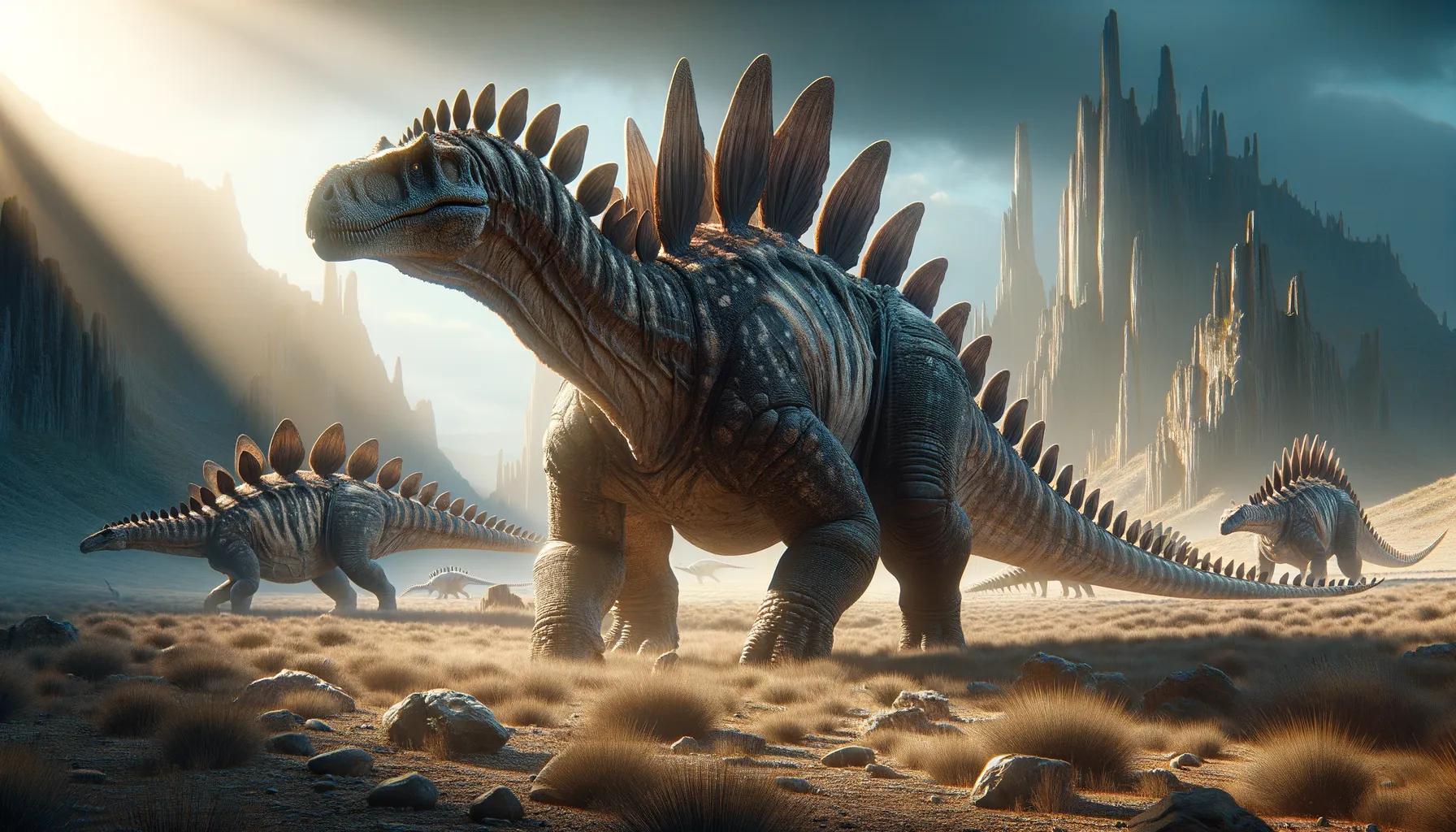
Omosaurus
Armored giant of the Jurassic plains.
Period
Jurassic
Length
Around 30 feet long.
Height
Approximately 8 feet tall at the shoulders.
Weight
Estimated to weigh up to 5 tons.
Omosaurus was a stegosaurid dinosaur known for its heavy, armored body and distinctive plates along its back. This herbivore roamed the Earth during the late Jurassic period and is primarily noted for its defensive features. Its discovery added significant insights into the diversity of stegosaurid dinosaurs, contributing to our understanding of these fascinating creatures. Early paleontologists initially named it based on fragmentary fossil remains, which have since provided clues about its lifestyle and adaptations.
Diet
Omosaurus was a herbivore, feeding primarily on low-lying plants. Its diet likely included ferns, cycads, and other prehistoric vegetation. It used its beak-like mouth to strip foliage and its large gut to digest tough plant material efficiently.
Hunting
Omosaurus did not hunt as it was a plant eater. Instead, it spent much of its time foraging for food. Its size and armor protected it from predators, eliminating the need for aggressive hunting behaviors.
Environmental challenges
Omosaurus faced numerous environmental challenges such as the risk of predation from major Jurassic predators. Its slow speed made it vulnerable, but its armored plates offered protection. Occasional changes in climate and plant availability in its habitat also required it to adapt to varying food sources.
Speed
Slow-moving due to its size and armor.
Lifespan
Likely lived several decades.
First discovery
First discovered in England in the 19th century.
Fun Facts
- The Omosaurus is an extinct genus of a stegosaurian dinosaur from the Late Jurassic period.
- Omosaurus means 'shoulder lizard,' a name it got due to its distinctive shoulder blade bones.
- This dinosaur was first discovered in England in the 19th century, making it one of the earlier stegosaurids to be identified.
- Despite its name, 'Omosaurus' is not frequently used today because its remains were later reclassified under different genus names like 'Dacentrurus.'
- It was a herbivore, likely feeding on low-lying plants, similar to other stegosaurs.
- Its body was protected by a series of bony plates and spikes, a common feature in its family.
- The reclassification of its fossils makes the Omosaurus a great example of how scientific names can change over time as new discoveries happen.
Growth and Development
Omosaurus hatched from eggs and underwent significant growth to reach its massive adult size. Juveniles were likely more agile and less armored, gradually developing the characteristic defensive plates. The growth rates of these dinosaurs were influenced by their food availability and environmental conditions. A steady diet of nutritious plants was crucial for their development.
Habitat
Omosaurus lived in what is now Europe, inhabiting lush, forested environments. It thrived in areas with abundant plant life to support its herbivorous diet. Its habitat included open plains and woodlands, providing ample resources and cover from predators. The climatic conditions of the late Jurassic were generally warm, supporting diverse ecosystems.
Interaction with other species
Omosaurus likely lived alongside other herbivorous dinosaurs, engaging in non-competitive foraging. Predatory dinosaurs, like Allosaurus, posed a threat, but its armor served as a deterrent. It might have had symbiotic relationships with smaller animals that helped keep its skin clean. These interactions highlight a complex ecosystem with multiple species co-existing.
Natural lifespan
Omosaurus might have lived up to 30 years in the wild.
Reproduction
Omosaurus laid eggs, possibly in nests constructed on the ground. Parental care might have been limited, with juveniles being self-sufficient from a young age. They relied on group nesting sites to increase the survival rate of their offspring. Hatchlings grew rapidly to achieve sizes that reduced predation risks.
Social behaviour
Little is known about the social behavior of Omosaurus, but it's believed they may have lived in small herds. This herd behavior provided protection against predators. Communication might have been limited to visual signals or sounds, ensuring group cohesion. Herding allowed for shared learning and efficiency in foraging.
Fossil locations
Fossils of Omosaurus have been primarily found in England. These fossils provide valuable information about the diversity of stegosaurids in the Jurassic period. The scattered nature of finds indicates they lived in various parts of Europe. The documented fossils include vertebrae, limb bones, and some of the iconic back plates.
